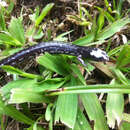Description
provided by AmphibiaWeb articles
Diagnosis: Oedipina carablanca is a vividly marked salamander that can be distinguished from other species in its genus by the following characters: dark brown to black ground color with a large occipital light blotch on top of the head plus numerous light spots on the body and tail; broad head; short, broadly rounded snout; moderately sized, robust body (47 - 54 mm standard length, 107 - 128 mm total length); 17 - 18 costal grooves; relatively long legs; palmate hands and feet (Savage 2002).Description: Oedipina carablanca is a medium-sized salamander, with relatively long limbs, a wide head, and a broad, rounded snout (Savage 2002). This species measures 47 - 54 mm from snout to vent, and 107 - 128 mm in total length (Savage 2002). The body has 17 - 18 costal grooves total and 8 costal grooves between adpressed limbs (Savage 2002). The tail is relatively short and thick for an Oedipina, only 56 - 58% of total length. Eyes are moderately sized. O. carablanca lacks maxillary teeth but has 10 - 12 vomerine teeth (Savage 2002). Hands and feet are relatively large and quite flattened and palmate, with thick webbing between each digit (Brame 1968). The tail is relatively short, thick and rounded with some constriction at the base, measuring 1.4x the standard (snout-vent) length (Brame 1968).Coloration in life: O. carablanca is dark brown with a large, light-colored occipital blotch, white splotches near its head and broken white spotting further along the body (Savage 2002; Brame 1968). The upper lip is paler than the lower lip, and the eyes are a dirty yellow (Brame 1968). Limbs are brown with extensive white areas, and the end of the tail is mostly white (Brame 1968). The underside is gray, with clear patches near the gular fold and the bases of the limbs (Brame 1968). Similar species: Oedipina carablanca is visually distinct from other members of its genus. Although it somewhat resembles members of Bolitoglossa, O. carablanca is distinguished by its sublingual fold and higher number of costal grooves as well as by its coloration (Brame 1968).A Spanish-language species account can be found at the website of Instituto Nacional de Biodiversidad (INBio) (http://darnis.inbio.ac.cr/FMPro?-DB=UBIpub.fp3&-lay=WebAll&-Format=/ubi/detail.html&-Op=bw&id=4355&-Find).Species authority: Brame (1968). García-París and Wake (2000) have subsequently placed this species in the subgenus Oedipinola, under the genus Oedipina. The species name is from Spanish, meaning "white-faced" (Brame 1968).
Distribution and Habitat
provided by AmphibiaWeb articles
Oedipina carablanca is endemic to Costa Rica (Savage 2002). Although it is rare and specimens are known from only four localities (Finca Los Diamantes, Guapilles; Pocora, a private reserve; Reserva las Brisas de Alegría; Alto Guayacán), it may be more widely distributed (Bolaños et al. 2009). It is found from 60 - 750 m above sea level (Stuart et al. 2008). Little of its original Atlantic lowland moist forest habitat remains; this species has been found within rotting logs and under bark of fallen trees in scrublands, banana plantations, and young secondary forest (Stuart et al. 2008).
Life History, Abundance, Activity, and Special Behaviors
provided by AmphibiaWeb articles
Whereas most members of the genus Oedipina are fossorial or semifossorial (Savage 2002), this species appears to be mainly terrestrial, found in rotting logs. Because it has also been found under bark of fallen trees, there has been speculation that it may be arboreal as well (Stuart et al. 2008). O. carablanca is a direct developer (Stuart et al. 2008) and, like other members of its genus, it probably does not exhibit parental care (Savage 2002).Species in this genus are known to coil up upon being disturbed, and may even begin flipping their bodies if they are particularly disturbed (Savage 2002).
Life History, Abundance, Activity, and Special Behaviors
provided by AmphibiaWeb articles
Extensive habitat fragmentation and loss is believed to be the primary cause of O. carablanca's population decline and current low abundance. Both primary and secondary forest habitat have been removed for plantations, human settlement, and livestock. It does occur within two protected areas, Pocora and Reserva las Brisas le Alegria (Stuart et al. 2008).
Oedipina carablanca: Brief Summary
provided by wikipedia EN
Oedipina carablanca, commonly known as the Los Diamantes worm salamander, is a species of salamander in the family Plethodontidae. It is endemic to Costa Rica and is only known from its type locality, Los Diamantes, near Guápiles, Limón Province.
Its natural habitats are tropical moist lowland forests, plantations, rural gardens, and heavily degraded former forest. It is threatened by habitat loss.
- license
- cc-by-sa-3.0
- copyright
- Wikipedia authors and editors

